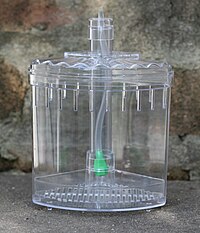
Photo from wikipedia
In this paper, the interaction phenomenon of two closely spaced symmetrical circular plate anchors buried at shallow depth in homogenous and layered sand strata was carefully observed from a series… Click to show full abstract
In this paper, the interaction phenomenon of two closely spaced symmetrical circular plate anchors buried at shallow depth in homogenous and layered sand strata was carefully observed from a series of large-scale model tests. A numerical model is further proposed by validating the experimental data. The motivation for the present investigation actually arrived from the fact that the uplift capacity of anchors is often analyzed as a single entity, whereas the anchors are actually placed in group. The present experimental observations revealed that the interacting anchors experience higher displacement along with the significant reduction in the uplift capacity at the closer spacing. Similar to the single anchors, the uplift capacity of interacting anchors increases with the embedment depth. The size effect of the anchor plate is found to be a significant parameter in pronouncing the interaction effect. However, the rate of reduction in the uplift capacity mainly depends on the embedment depth and the relative density of soil. Unlike the homogenous sand bed, the shear mobilization is not uniform in a layered sand bed although the rupture surface is progressive from the edge of the anchor plate to the ground surface in both the cases. The proposed numerical model performs well in capturing the interaction of circular plate anchors in homogenous and layered sand bed as well. The quality of the results is assured by comparing with the similar works available in the literature.
Journal Title: International Journal of Civil Engineering
Year Published: 2019
Link to full text (if available)
Share on Social Media: Sign Up to like & get
recommendations!